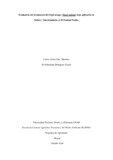Mostrar el registro sencillo del ítem
Evaluación del crecimiento del frijol mungo (Vigna radiata) bajo aplicación de fósforo y bioestimulante en El Espinal-Tolima.
| dc.contributor.advisor | Montealegre Torres, Francisco José | |
| dc.coverage.spatial | cead_-_ibagué | spa |
| dc.creator | Páez Martínez, Carlos Arturo | |
| dc.creator | Rodríguez García, Jei Sebastiana | |
| dc.date.accessioned | 2020-10-16T03:05:36Z | |
| dc.date.available | 2020-10-16T03:05:36Z | |
| dc.date.created | 2020-10-01 | |
| dc.identifier.uri | https://repository.unad.edu.co/handle/10596/36835 | |
| dc.description.abstract | El frijol mungo (Vigna radiata) es una leguminosa con grandes propiedades, este cultivo se utiliza en el mejoramiento de suelos, gracias a que son plantas fijadoras de Nitrógeno y como unidad productiva. En El Espinal Tolima se ha venido implementando este cultivo en pequeñas extensiones en épocas de verano. Este cultivo se realiza sin una técnica agronómica adecuada que permita lograr una mayor producción y rentabilidad, evitando tener una alternita llamativa e importante para la rotación de cultivos en la región. El objetivo de esta investigación fue evaluar el comportamiento del frijol mungo, sometido a diferentes tratamientos, donde se le realizaron aplicaciones de Fosforo y bioestimulante hormonal, de manera foliar en la etapa vegetativa (V4) del cultivo y en pre siembra. Se desarrollaron cinco (5) tratamientos en bloques al azar en un diseño experimental de 4 repeticiones, que permitió observar y analizar la reacción y el desarrollo de las plantas al tratamiento sometido. Los indicadores evaluados fueron la longitud de raíz, longitud de la planta y la producción por cada tratamiento. Los resultados demuestran el efecto positivo de la aplicación del bioestimulante hormonal. Este regulador de crecimiento obtuvo resultados que sobresalieron a los demás tratamientos, la aplicación foliar y tratamiento en semilla con el bioestimulante hormonal logro plantas de mayor longitud en raíz y plantas en todas las etapas del cultivo, como por ejemplo, se observó que el bioestimulante hormonal aplicado en semilla obtuvo una longitud de planta de 18,4 cm a los 15 días después de siembra, superando hasta por 6 cm a las plantas del tratamiento testigo y logrando un mejor rendimiento que los tratamientos donde se aplicó Fosforo en Pre-siembra y de manera foliar en la etapa vegetativa del cultivo, los cuales obtuvieron plantas de un tamaño con un longitud menor en promedio de 4,5 cm . Sin embargo, la aplicación del fosforo de manera foliar tuvo un mejor resultado que el fosforo en pre siembra, este fosforo granulado logro una mejor asimilación por la planta que el fosforo incorporado al suelo influyendo en el crecimiento y rendimiento de la planta. Con esto se logra concluir que con un plan de fertilización adecuado se puede tener en cuenta esta variedad de frijol para una futura expansión agrícola en la región. | spa |
| dc.format | ||
| dc.title | Evaluación del crecimiento del frijol mungo (Vigna radiata) bajo aplicación de fósforo y bioestimulante en El Espinal-Tolima. | |
| dc.type | Proyecto de investigación | |
| dc.subject.keywords | Desarrollo Rural, Fertilizante, Foliar, Incorporación, Leguminosa, Crecimiento. | spa |
| dc.description.abstractenglish | The mung bean (Vigna Radiata) it is a leguminous with great properties, this crop is use in the improvement of soil, thanks to the fact that they are nitrogen fixer plants and as a productive unit. This crop is being implemented In the Espinal- Tolima in small extensions in summer seasons. The Mung bean crop is made without an appropriate agronomic technique that allows a greater production and rentability, avoiding having a significant alternative for the rotation of the crops in the region. The goal of this investigation is to evaluate the behaviour of the mung bean when subjected to different treatments where the application of phosphorus and hormonal bio stimulants in a foliar way in the vegetative stage (V4) of the crop and the pre sowing was made. 5 treatments were developed in random blocks in an experimental design of 4 repetitions, that allowed us to observe and analysed the reaction and development of the plants to the treatment they were subjected to. The evaluated indicators were the length of the root, the length of the plant and the production for each treatment. The results show a positive effect in the application of hormonal bio stimulant. This regulator of growth got outstanding results compare to the other treatments. The foliar application and seed treatment with hormonal bio stimulant achieved plants with greater length in roots and plants in all stages of the crop, for example, we observed that the hormonal bio stimulant applied in the seed gain a length in the plant of 18,4 cm 15 days after the first sowing, overcoming, for up to 6 cm, plants with the witness treatment and achieving a better performance than the treatment were phosphorus was applied in the pre sowing and in a foliar way during the vegetative stage of the crop, which achieve plants with a shorter length in average of 4,5 cm. Regardless, the application of phosphorus in a foliar way achieved a better result than the phosphorus in the pre sowing, this granulated phosphorus achieve a better assimilation by the plant than the phosphorus incorporated to the soil influencing in the growth and performance of the plant. With this we conclude that with an appropriate fertilization plan it’s possible to keep this variety of bean in mind for a future agricultural expansion in the region. | spa |
| dc.subject.category | spa |
Ficheros en el ítem
Este ítem aparece en la(s) siguiente(s) colección(ones)
-
Agronomía [574]















